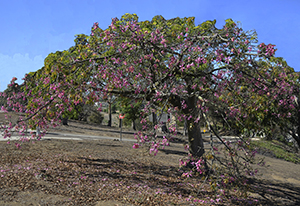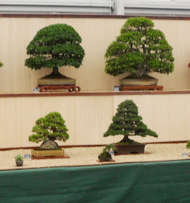The Floss Silk Tree
Chorisia Speciosa
by Lew Buller
In San Diego, the Chorisia speciosa (floss silk tree) starts blooming in early fall and continues to carry flowers until late December, offering color at an otherwise drab time of year. The tree is used as a street tree in San Diego, and its flowers are one of the main reasons.
Its hardiness, its unusual green bark and thorny trunk, its rapid growth–3 to 5 feet a year for the first few years; 30 to 60 feet at maturity–and its tolerance for dry, hot weather make this Brazilian native a good choice for landscapes here.
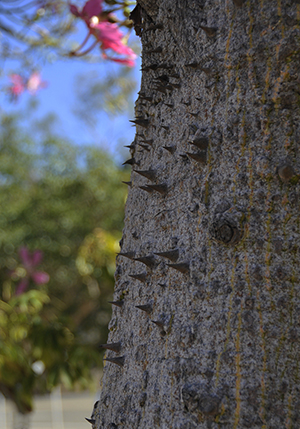
Based on the size of the trunk, I estimate this tree to be forty or more years old. Most of the thorns are gone, but some, still very sharp, remain. When a variety was developed that had no thorns, the City switched to that one.
After the floss silk tree flowers, it produces large balls of cottony kapok, and when kapok is shed, it looks like snow beneath the tree. It is a member of the kapok family of flowering trees and shrubs but its kapok is not so good as that from the kapok tree itself. Older readers may remember that during World War II, kapok was used in life preservers, now it is used as stuffing in pillows, as insulation, and as a substitute for absorbent cotton in surgery.
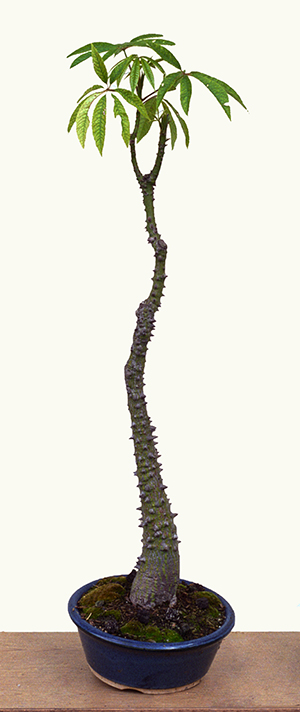
The Bonsai Pavilion at San Diego’s Wild Animal Park has a fully grown floss silk tree next to it, and that tree is the parent of this 1998 tree. An early bonsai enthusiast started two trees from seed in 1988, and in March 1998 sold one to me. The tree was transplanted annually for the first four years, and on an as-needed basis after that. To slow growth down, it was under-potted it severely. I was fascinated by the thorny trunk; no one else in San Diego had one as a bonsai, so I paid her a hundred dollars for ten years of growing. The March 14, 1998 photo shows what I brought home.
The green color of the bark and sapwood made me think that the floss silk tree might be like the paloverde tree. Paloverde means green tree in Spanish; “Photosynthesis in paloverde is actually performed by the green branches and twigs, as the leaves appear only briefly.” 1 I don’t know, however, whether the floss silk tree bark performs photosynthesis.
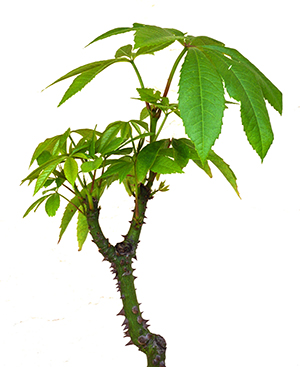
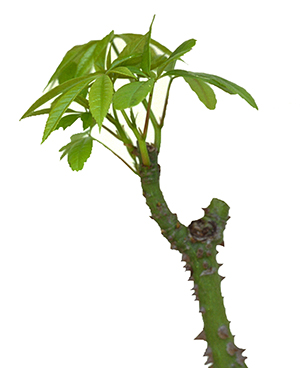
L to R: Before and After
As the tree was a bit tall for its trunk diameter–it did not meet the guideline that the height of a tree should be six times the diameter of its trunk--I decided to cut off part of the top and see what happened. On July 23, 1998, with one snip, the tree went from Beforeto After. The tree came back strongly, so on March 20, 1999 I took off the entire top. This was purely an experiment; I had no idea what to expect, but it was my tree and my money, so I did it. While I was at it, I transplanted it to a much larger container, as I wanted to thicken the trunk.
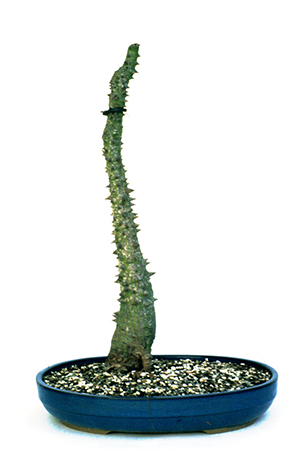
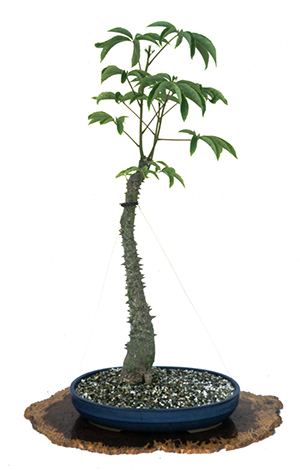
L to R: Top removed completely. New top.
By April 20, 1999, the top was beginning to regrow. I have never seen such a top-dominant tree. In growing to be nearly 6 feet tall, only the central leader lived; all side buds died off. It would be a challenge to create any kind of a branch structure; all branches would have to be developed simultaneously and none of them allowed to become a dominant leader.
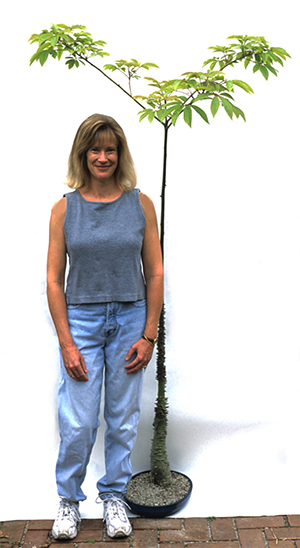
By April 2002, it was taller than my wife. I decided to stop killing the tree by inches, and on May 20, 2002, made a major cut, this time low on the trunk. Never one to waste things, I took the section of trunk removed, cut it into three pieces, and potted the pieces separately. Bougainvillea respond to this technique. Cut a section out of a bougainvillea vine in July/August, pot it in pure sand, water it and put it in the sun, and it will sprout both roots and branches. The undifferentiated meristematic cells above ground differentiate to become branches; those below ground become roots.
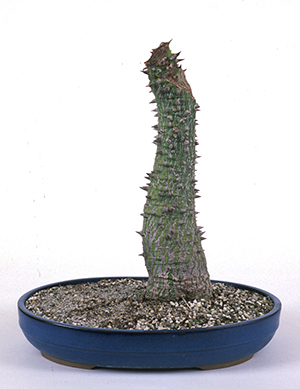
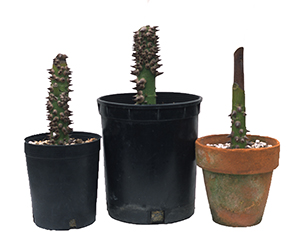
Because young floss silk trees seem more like weeds than like trees, I had no idea whether the cuttings would take. The green outer bark was thick and extremely wet; the center of the cutting had not really begun to lignify; there were no buds visible on any section of the trunk. Nevertheless, the cuttings went right into sand in various sizes of pots.
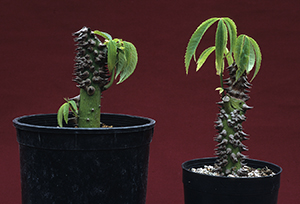
Two of the cuttings leafed out, but the third one died, possibly from over watering. The new leaves did not originate at the very tip, but lower down on the cutting, meaning that one day I would have to cut off the dead top. That was not a cause for worry; the tree had proved to be resilient and cuts healed over well.
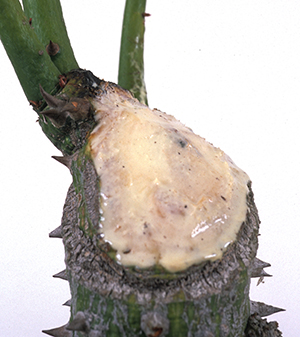
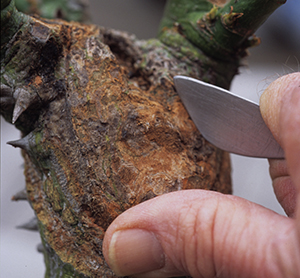
As proof of the latter statement, take a look at the size of the final cut on the trunk of the mother tree just after new branches began to grow, (May 2003). The wound was sealed with a very thin layer of carpenters’ glue–too much and it has to be scraped off later.
Two years later the cambium had almost completely closed over. Only the small dark spot at the top of the cut remained to be healed. Scraping the rough new cambium with a spatula from time to time smooths the cambium and stimulates further growth. The same technique can be used on maples, strawberry guavas, and other smooth-barked trees where rough ridges would be unsightly.
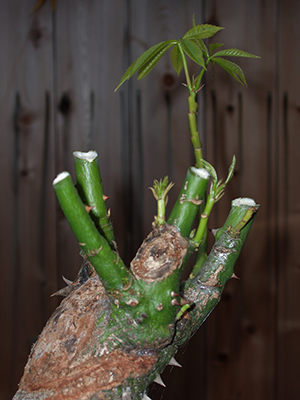
After the chopping block
In the two-year interval since being cut, the tree had grown a canopy of sorts. The canopy didn’t look bad, but it would grow taller rapidly. It needed its branches to start lower down and needed more of them. So it was back to the chopping block. As the tree regrows its crown, the tip growth on all branches will be pinched to keep them even and unwanted buds will be scratched off with a fingernail. Since the green growth is so soft, I have not yet tried any sort of wiring except tie-downs.
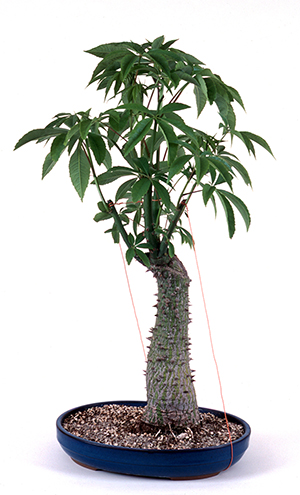
Rapid growth heals the wound; tie-downs shown.
As expected, the dead top of the cutting had to be removed, but the upright branch provided enough carbohydrates to heal the cut. One of the two surviving cuttings was given away. the other kept for a learning tree. I have it in 2014.
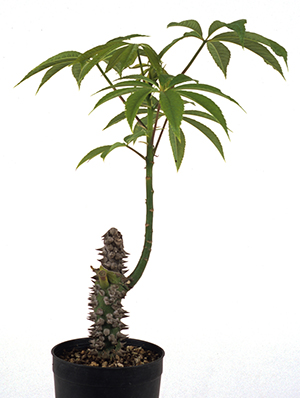

A second branch sprouted at the base of the first one and both were left on to help heal the cut made when the dead top was removed. The second branch grew rapidly and would have produced a knot larger than the rest of the trunk, so it was cut off before it became too large. The new wound, with a thin coat of carpenters’ glue on it, healed.
In the past, I have tried to make trees do things they didn’t want to do. For example, I tried training a bougainvillea in the cascade form. Not very successful. The floss silk tree wants to grow to be 30-60 feet tall and it wants to do it in a hurry. I want the tree to stay less than 30 inches tall and to grow slowly. Want to take bets on the tree?
In the ground, the tree drops its leaves after flowering or when the temperature is lower than 270 F; in my back yard, neither condition occurs, the tree is evergreen, constantly putting out new growth, making it hard to determine when best to transplant. The tree looked healthy and was putting out new growth in March 2006, leading me to transplant it then.
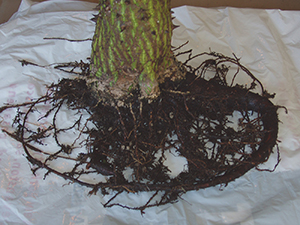
The first step was to scrape off the topsoil; as it came off, very nice buttressing began to appear on one side. With the plant bare-rooted, the cause of the buttressing was evident; it was from one major root that had circled around in the pot. It was a good thing the roots had not been trimmed before they were all visible. Small roots were beginning to grow again on the side where the largest cut had been, but the major source of nutrients was the one large root. While working to develop the top, I had neglected to develop the roots. Looking back, the single large root should not have been a surprise; this is a tree that can grow to 60 feet and obviously would need good strong rootage.
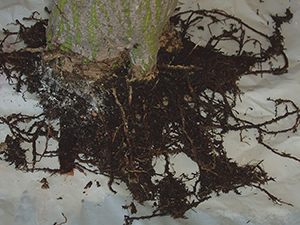
Knowing the tree had survived having its entire top removed and knowing that it would send out roots from a bare stem, I cut the major root off. No need to go to Las Vegas to gamble; I can do it in my own back yard. A three and one-quarter inch cut was made through the main root, almost parallel to the bottom of a pot, and several holes were punched at the base of the trunk and covered with rooting hormone.
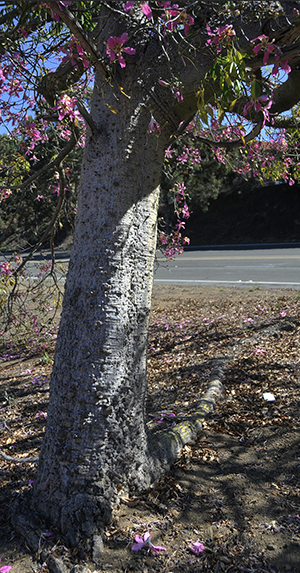
The tree in the ground had an 18” trunk at the base and a similar dominant root on one side. Branches on the opposite side died off, but I don’t know whether they died off first and then roots on that side were not provided with carbohydrates and died or the roots died first. On my young tree, when the large cut on the trunk was made, the roots stopped growing on one side and needed to be regrown.
I continued to cut away at the branches. I had some success in forcing low growth on the four branches which budded out just above the major cut on the mother tree. In 2006, the four major branches supported 10 secondary branches. (Two back branches, one primary and one secondary, are hidden behind front branches.) New growth still has a tendency to grow straight up, but it is possible to use green plastic garden tape and lightly tie new branches to a wooden stake without killing the new branches. Although developing the branch structure resulted in many scars, in time the scars will heal over and not be so prominent.
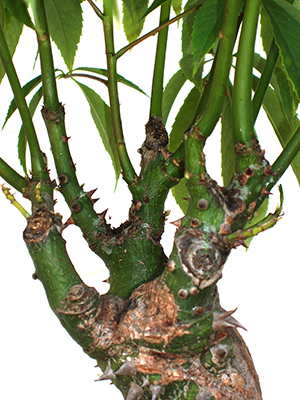
Four primary branches, 10 secondary branches
While the blue growing pot went well with the light green of the leaves, it seemed too shallow for such a large trunk. A deeper, unglazed pot, roughly two-thirds the width of the canopy, would be home to the tree for a while. The pot is between 50 and 55 years old and appears to be at least partially hand made. The drain holes are very rough and irregular and the inside bottom shows six square imprints where supports were used to keep the pot from sagging when firing it upside down. It came from a client who had been in Japan with her husband shortly after WWII. He liked bonsai and would take a backpack, go off to back-country villages looking for pots, and come back with a full load. In the early 90’s, he decided he needed more excitement in his life and divorced, leaving all his bonsai equipment temporarily with her. She proceeded to sell it at fire-sale prices, and sold the pot to me for $3.50.
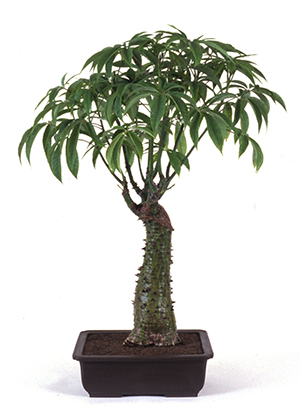
May 15, 2006 the tree turned 18, old enough to drink; clearly, developing a satisfactory crown is a job that will never be finished. I would, however, continue to try. Both the top and the roots need to be balanced. June 12, 2013, the next time I transplanted, I found the roots had continued to come mostly from the stub of the large root I had trimmed before. I was determined to try balancing the roots one more time.
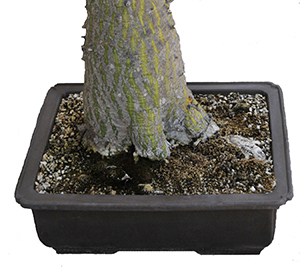
Roots circled the bottom of the pot again. They had to come off and the large stub had to be trimmed back further. The stub was about 13/4 inches across.
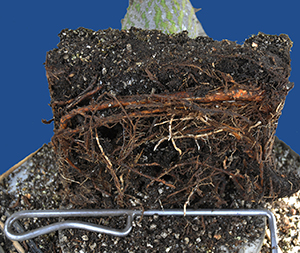
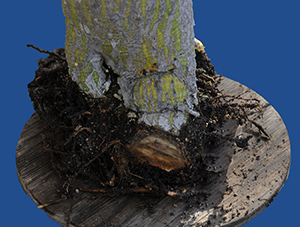
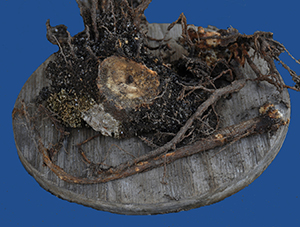
The top came in for its share of attention as well. It had grown taller in the interim years. After 7 years of growing, it was quite tall again. After 27 years, it still had stubs of its thorns. I like them and had never cut them in spite of being stuck a few times.
Three snips with a sharp cutter fixed the height problem in under 30 seconds. Two and one-half months of growing in San Diego sun brought a revitalized top.
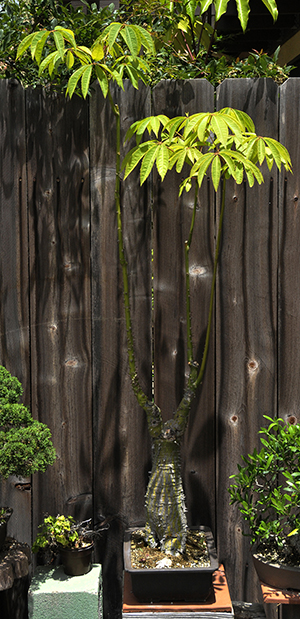
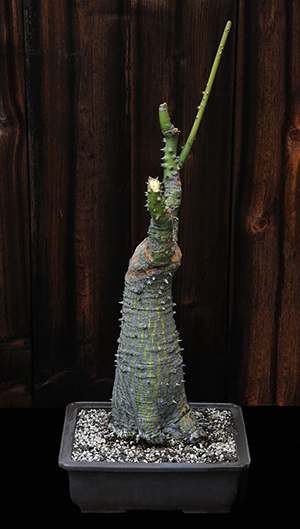
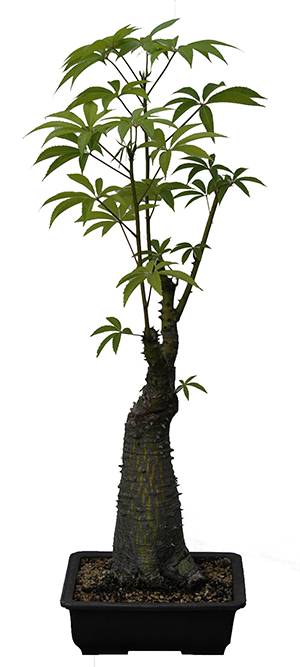
The challenge now is to continue to balance the branches so they all grow pretty much at the same rate; otherwise, the stronger branches will sap all the nutrients from the weaker branches and they will die.
Stem cells that can be used to grow human organs have been in the news for several years now. Botanists have long known of their characteristics; in plants, the tissue which contains undifferentiated stem cells is called meristematic. Put a section of a plant with meristematic tissue in the ground and the top will grow branches while the portion underground grows roots. The Chorisia speciosa seems to be particularly rich in meristematic cells–that’s why the roots and top can be cut so severely.
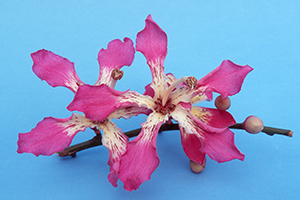
If you would like to learn more about meristematic cells, do a little research on the Internet.
(Endnotes) Martin, Laura C., The Folklore of Trees and Shrubs, The Globe Pequot Press, Chester, Connecticut, 1992, p. 144.

